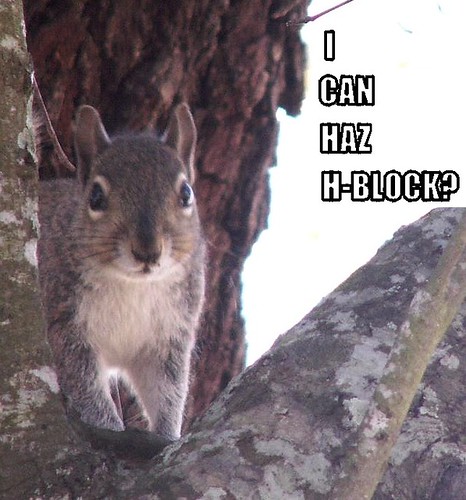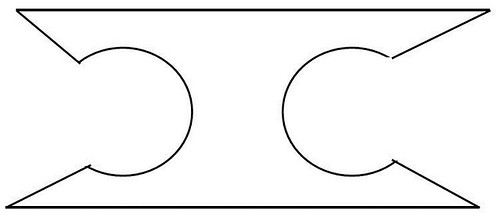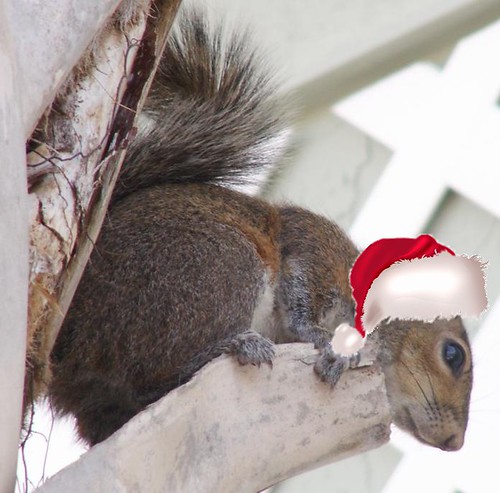A Squirrely Christmas

On the first day of Christmas, we brought unto its end:
seven days of worries,
six bulbs-a-bright'ning,
five more flick'RING!,
four dimming lamps,
three wires chewed,
two outlets dead,
and a six-splitter shorting with a POP!
First, many thanks go to Larry the Circuit Detective, both for his awesome website and for his guidance. I have never futzed around with electrical wiring, so I am a complete novice when it comes to this sort of thing. My idea of using electrical tape is to stick it in an art project.
Second, I deeply appreciate the helpful folks at Progress Energy who were there for us on Christmas Day, including Beverly who took my call, and the-techs-whose-names-I-wish-I'd gotten, so I could thank them properly for coming out to our place less than an hour after I'd spoken with Beverly.
Our electrical adventure began a week ago, on December 19, when my desk lamp started flickering -- not much, but enough to get my attention. I thought it was odd that my fluorescent bulb was having trouble, considering that the lamp was fairly new.
Then, around 2 a.m. on December 20, I heard a loud POP! And lost power to my lamp and computer -- and the bedroom -- and the hallway light.
And I smelled burnt electrical insulation.
Yikes.
The power we still had kept browning out. I had visions of having to get the whole house rewired (it turns 32 next year). If it didn't burn down first. Turning main power off and back on at the circuit box didn't help matters.
Conditions were not quite as bad as feared. The smell was traced to a 16-year-old surge suppressor that had given up the ghost. Once that was unplugged, I was able to reset the circuit breaker that I couldn't budge before, restoring the power we had lost.
But our lights kept flickering, especially when our fridge -- also turning 32 -- began a new cycle. The best the microwave could do was give me lukewarm coffee, even at its highest setting. I looked up electricians, then got a recommendation because most of them were unknowns as far as the Better Business Bureau was concerned.
We also looked at fridge models. Ours had begun making clickety-ratchety sounds after the short. It didn't sound happy at all. Would it die before Christmas? Would we have to brave the holiday shopping throng for a new one while our frozen vegetables wept? How long would delivery take?
If our home wiring was on the fritz, would it kill a new fridge? How long would a rewiring job take, especially given the holidays? What order should we do things in? We had spent the better part of a day doing fridge research and narrowing down our choices and alternates, before deciding that maybe we didn't want to chance sticking a new appliance on what could be a dicey electrical system.
I forget what I Googled -- probably "home wiring" or some such -- but it brought me to Larry Dimock's site. After reading the site's background info on home wiring I scooted over to his electrical fire, safety, and electrical myths sections. They pretty much eased my fears about the house going up in smoke.
Then I found his Weird Light Behavior page, and that seemed to fit. Because we had a whole lotta weirdness goin' on.
We had begun turning our fridge off for several hours at a time, to give it a rest from its labors. Maybe it was the main culprit for draining down the system. With the fridge off, I had moved the microwave to an outlet controlled by a different circuit. The microwave worked fine, but the lights brightened when I turned it on, then dimmed again when it was off.
I moved the microwave back to its old outlet. It behaved well there, too (no longer making lukewarm coffee), but even with the fridge off, the lights still dimmed -- the opposite effect of what I'd gotten at the other outlet. The outlets were on different circuits, but those circuits both carried 20 amps.
Okay, I thought: one circuit made lights brighten and the other circuit made them dim when the microwave was on. Even more curious: most of the lights that brightened and dimmed were themselves on a different circuit still.
And then -- at the same outlet where the lights had dimmed, now (and with the fridge turned on) the microwave made the lights brighten when it was turned on! But then the lights dimmed. And when the microwave was done, the lights brightened again -- but they were not as bright as they had been when the microwave first went on.
Say what? (It had to do with load distribution.)
Add in a couple of outlets that worked intermittently (they were a longer-term issue), for good measure.
According to Larry's Weird Light Behavior page, our flickering/dimming/brightening problem was likely an issue for the power company, not an electrician.
I'd been keeping an Electrical Problem Log (I've presented only a portion of the weirdness here). Mary and I had surveyed the house several years ago, so we knew which circuit controlled what. I had photographed our circuit box, annotated the photos with numbers and amp figures, and added a key that listed everything out. Now I took a graphic layout of the house, added all the electrical outlet locations, and labeled them according to which circuit they were on.
Then I took advantage of Larry's $15 e-mail consulting, filled out his advice request form, and sent him an 836-word description of the problem, along with a 556-word "possibly related items" addendum. In between, I asked, "Does this fall under the 'weird light behavior' -- e.g., something requiring a call to the power company? (Open main or open neutral?)"
I heard back from him early on Christmas morning. Open neutral was the likely culprit.
(I was jumping like a kid inside: I guessed right! Geek props for me! Yaaay!)
But I wanted to take action before something else blew. An open neutral can do nasty things to electronics.
There were ways to approach the power company, to make sure they took all the steps to chase down the problem. As it turned out in my particular case, all the tech had to do was eyeball the power pole for about a second, before he said, "Squirrel chewed that off."
I couldn't even tell what that was.
Mary wondered if the squirrel had been going after vegetation, since that pole (and more) has been invaded by both skunkvine and Virginia creeper. I passed her question on to the tech.
"Nope," he said. "They go after the aluminum."
He showed me an "H-block," which for the life of me I have been unable to find doing a Google search (using "block," "clamp," "connector," "housing," "power supply," "electrical," "hardware," etc., in various permutations). Here's my primitive edge-on depiction (just imagine shallow serrations on the hole edges). I'd guess it measures roughly 2 x 2 x 1 inches:

In the wild, squirrels chew on hard objects, like bone, to care for their teeth. Like a beaver, a squirrel's teeth don't stop growing, so they need ways to file them down. Wood won't do the trick because it's too soft.
In neighborhoods like mine, that means the squirrels go after aluminum.
The tech pointed to a chain link fence across the street. "The aluminum ties that hold that fence together? They chew those down, too."
In the course of chewing the H-block, our squirrel also chewed through the "open neutral" wire. Make that wires: half the wire leading to our house, half the wire leading to a neighbor's house, and half the wire feeding the other two. The neutral is non-lethal when chomped.
"If you have deer horns in your yard, they chew on that," the tech said.
I asked, "Is it a good idea for me to get deer horns, to keep the squirrels away from the wires?"
"If you do, you'll have half the neighborhood squirrels coming here."
Guess I won't get deer horns, then.
He and his colleague fixed the problem in about ten minutes, and our electrical performance is back to what it had been before Dec. 19. Fridge is happy, lamps are steady, microwave is well-behaved. For now, it seems, our home wiring system is fine, and nothing needs replacing except the dead surge suppressor.

Merry Christmas to all,
and to all a good bite.












0 Comments:
Post a Comment
<< Home